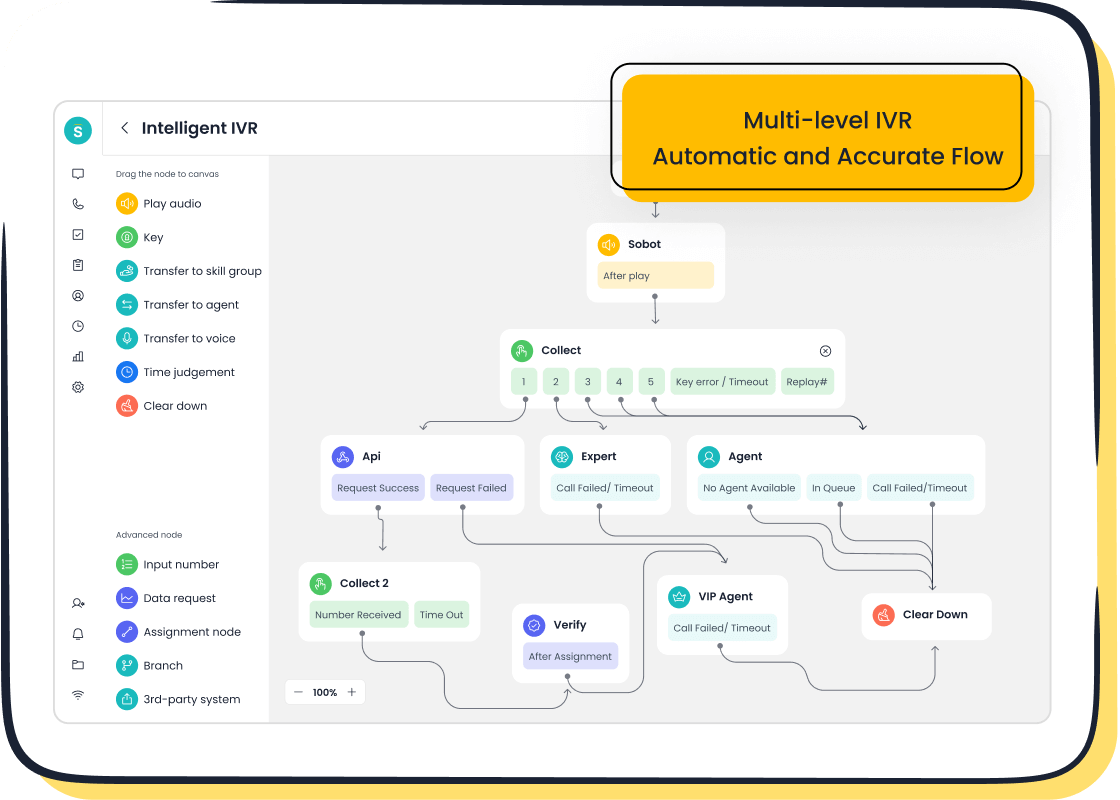8 Essential Customer Service Skills for 2025 and Beyond

Customer service is evolving faster than ever. By 2025, customers will expect brands to anticipate their needs before problems arise. For instance, 77% of consumers demand proactive support, while 87% value personalized interactions. Companies like Sobot, with AI-powered solutions, are already redefining experiences to meet these expectations. Mastering the 8 customer service skills every employee should know will ensure you stay ahead in this dynamic landscape.
Empathy: The Foundation of Customer Connections

What is empathy in customer service?
Empathy in customer service means understanding and sharing your customers' feelings. It’s about stepping into their shoes and seeing the situation from their perspective. When a customer feels frustrated or confused, your ability to acknowledge their emotions can make all the difference. Empathy isn’t just about solving problems; it’s about making customers feel valued and heard during every interaction.
For example, imagine a customer struggling with a product issue. Instead of jumping straight to a solution, you might say, “I understand how frustrating this must be for you. Let’s work together to fix it.” This simple acknowledgment can transform the tone of the conversation and build trust.
Why empathy is one of the most important skills for customer service.
Empathy is one of the top customer service skills because it directly impacts customer satisfaction and loyalty. Studies show that empathetic interactions build trust, reduce customer churn, and even increase forgiveness for mistakes. Customers who feel understood are more likely to stay loyal and recommend your brand to others.
Companies like Ritz-Carlton and Zappos have demonstrated how empathy can elevate customer experiences. Ritz-Carlton empowers employees to resolve guest issues on the spot, fostering loyalty. Similarly, Zappos uses customer feedback to improve services, showing they genuinely care about their customers’ needs. These examples highlight why empathy is one of the most important skills for customer service in today’s competitive landscape.
Practical ways to develop empathy in customer interactions.
Developing empathy starts with active listening. Pay close attention to what your customers are saying and how they’re saying it. Use phrases like, “I hear you,” or “That sounds challenging,” to show you’re engaged. Practicing patience is another key step. Give customers the time they need to explain their concerns without interrupting.

Training tools like Sobot’s Voice/Call Center can also help. With features like call tracking and AI-powered Voicebots, you can analyze customer interactions to identify emotional cues and improve your responses. Additionally, role-playing exercises with your team can prepare you for handling real-life scenarios empathetically.
By focusing on empathy, you’ll not only enhance customer interactions but also strengthen relationships that drive long-term loyalty.
Active Listening: Understanding Customer Needs
The role of listening in effective customer service.
Listening is the backbone of great customer service. When you truly listen to your customers, you uncover their needs, frustrations, and expectations. It’s not just about hearing words—it’s about understanding the meaning behind them. Active listening helps you connect with customers on a deeper level, showing them that their concerns matter.

Imagine a customer calling about a delayed delivery. Instead of rushing to explain the situation, you pause and let them share their experience. This approach builds trust and sets the stage for a productive conversation. Tools like Sobot’s Voice/Call Center make this easier by offering features like call tracking and real-time monitoring, helping you focus on what customers are saying and how they’re feeling.
How active listening improves customer satisfaction.
Active listening transforms customer interactions into positive experiences. Here’s how it makes a difference:
- It builds trust and rapport, creating a stronger relationship with customers.
- It enhances problem-solving by helping you pinpoint the root cause of issues.
- It makes customers feel heard and valued, boosting satisfaction levels.
- It reduces misunderstandings, ensuring accurate resolutions to concerns.
When customers feel acknowledged, they’re more likely to stay loyal and recommend your brand. For example, a study found that active listening reduces customer churn and increases positive feedback. By using tools like Sobot’s AI-powered Voicebot, you can analyze emotional cues and respond effectively, improving the overall customer experience.
Tips for enhancing listening skills in customer interactions.
Improving your listening skills starts with small, actionable steps:
- Stay present: Avoid distractions and focus entirely on the customer.
- Ask clarifying questions: If something isn’t clear, ask for more details.
- Summarize and confirm: Repeat key points to ensure you’ve understood correctly.
- Use technology wisely: Platforms like Sobot’s Voice/Call Center provide insights into customer conversations, helping you refine your listening approach.
By practicing these techniques, you’ll master one of the top customer service skills and create meaningful connections with your customers. Listening isn’t just a skill—it’s a way to show customers you care.
Communication Skills: Clear and Effective Interaction
Why communication is a cornerstone of customer service skills.
Communication skills are the glue that holds customer service together. When you communicate clearly, you make it easier for customers to understand solutions, follow instructions, and feel confident about your brand. Whether you're explaining a product feature or resolving an issue, your ability to convey information effectively can turn a frustrated customer into a loyal advocate.

Think about it—how often do misunderstandings arise because of unclear instructions or vague responses? By mastering clear communication skills, you eliminate confusion and build trust. Tools like Sobot’s Voice/Call Center help streamline communication by offering features like call tracking and real-time monitoring. These tools ensure your team delivers consistent and accurate information, making every interaction smoother.
The impact of clear communication on customer loyalty.
Clear communication doesn’t just solve problems; it strengthens relationships. Customers appreciate brands that communicate openly and consistently. For example:
- Email remains a favorite channel for 76% of French consumers when receiving offers and 75% for brand interactions.
- SMS and WhatsApp excel at delivering short, direct messages, perfect for instant updates.
- Omnichannel strategies, like those offered by Sobot, allow you to connect with customers on their preferred platforms, fostering loyalty.
Regular updates through emails or notifications build trust and keep customers engaged. When customers feel informed and valued, they’re more likely to stick around and recommend your brand. Sobot’s solutions, such as its unified workspace, make it easy to manage communication across multiple channels, ensuring every message resonates with your audience.
Strategies for improving verbal and written communication.
Improving communication skills doesn’t have to be complicated. Here are some practical tips:
- Simplify your language: Avoid jargon and use straightforward words.
- Be concise: Get to the point quickly without overwhelming your customer.
- Use active voice: Say “We’ll resolve this now” instead of “This will be resolved.”
- Leverage technology: Platforms like Sobot’s Voice/Call Center provide tools to analyze conversations and refine your approach.
For written communication, double-check for clarity and tone. For verbal interactions, practice speaking confidently and listening actively. By focusing on these strategies, you’ll master one of the 8 customer service skills every employee should know and create a better customer experience.
Problem-Solving: Resolving Issues Efficiently
What makes problem-solving an essential customer service skill?
Problem-solving is the backbone of excellent customer service. When you deal with customers, you’re not just answering questions—you’re solving problems that impact their experience with your brand. Whether it’s a delayed shipment or a technical glitch, your ability to resolve issues quickly and effectively can make or break the customer experience.
Why is this skill so critical? It directly affects key metrics like customer satisfaction and loyalty. For instance, companies that excel at problem-solving often see higher satisfaction scores and faster resolution times. Customers appreciate when their concerns are addressed without unnecessary delays, which builds trust and encourages repeat business.
In today’s fast-paced world, customers expect solutions in minutes, not days. That’s why mastering problem-solving is one of the 8 customer service skills every employee should know. It’s not just about fixing issues—it’s about creating a seamless and positive experience that keeps customers coming back.
Techniques for addressing and resolving customer issues.
Effective problem-solving starts with a structured approach. Here are some techniques to help you tackle customer issues efficiently:
- Identify the root cause: Ask targeted questions to understand the problem fully.
- Use decision trees: Simplify complex workflows to guide your actions.
- Leverage a centralized knowledge base: Quickly access accurate information to provide solutions.
- Communicate clearly: Keep customers informed about the steps you’re taking.
These techniques don’t just save time—they also improve outcomes. For example, using visual aids or decision trees can reduce resolution time by an average of 27 minutes per case. Additionally, centralized knowledge bases help agents find answers faster, cutting down on client-facing incidents by 50%.
How Sobot's Voice/Call Center supports problem-solving in customer service.
Sobot’s Voice/Call Center is a game-changer for problem-solving. Its intelligent features empower your team to resolve issues faster and more effectively. For instance, the platform’s call tracking and real-time monitoring tools help agents identify patterns and address recurring problems. This reduces the average resolution time and improves first-contact resolution rates.
The system also integrates seamlessly with your existing CRM, ensuring agents have all the customer data they need at their fingertips. With AI-powered Voicebots, you can automate routine inquiries, freeing up your team to focus on more complex issues. These advanced tools not only enhance efficiency but also elevate the overall customer experience.
By adopting Sobot’s solutions, you’ll streamline your workflows and deliver faster, more accurate resolutions. It’s a win-win for both your team and your customers.
Adaptability: Thriving in a Dynamic Environment
What does adaptability mean in customer service?
Adaptability in customer service means your ability to adjust to changing circumstances, customer needs, or unexpected challenges. It’s about staying flexible and resourceful, no matter what comes your way. For example, imagine a customer reaching out through a new communication channel you’ve never used before. Instead of hesitating, you embrace the opportunity to learn and deliver a seamless experience. That’s adaptability in action.
In today’s fast-paced world, customer expectations evolve rapidly. A study by Salesforce found that 76% of customers expect consistent interactions across departments, yet only 54% feel companies deliver on this promise. Your ability to adapt ensures you meet these expectations, even when the landscape shifts.
The importance of flexibility in handling diverse customer scenarios.
Flexibility is crucial because no two customers are the same. One might prefer detailed explanations, while another values quick resolutions. Adapting your approach to suit their preferences can make all the difference. For instance, Sobot’s Omnichannel Solution helps you manage interactions across platforms like email, social media, and live chat. This ensures you’re ready to meet customers wherever they are, without missing a beat.
Being flexible also helps you handle unexpected situations, like a sudden surge in inquiries during a product launch. By staying calm and adjusting your workflow, you can maintain high service standards and keep customers happy.
Tips for staying adaptable in a fast-changing customer service landscape.
- Embrace continuous learning: Stay updated on industry trends and new tools. Platforms like Sobot’s Voice/Call Center offer training resources to help you stay ahead.
- Leverage technology: Use AI-powered tools to automate repetitive tasks, freeing you to focus on complex issues.
- Stay customer-focused: Always prioritize the customer’s needs, even when processes or tools change.
- Practice resilience: View challenges as opportunities to grow and improve your skills.
By cultivating adaptability, you’ll thrive in any situation and deliver exceptional service, no matter what the future holds.
Emotional Intelligence: Building Stronger Relationships
Understanding emotional intelligence in customer service.
Emotional intelligence is your ability to recognize, understand, and manage emotions—both yours and your customers’. In customer service, it’s about staying calm under pressure, showing empathy, and reading emotional cues to respond effectively. For example, when a frustrated customer calls, your self-control helps you stay composed, while your empathy allows you to connect with their concerns. This combination builds trust and sets the stage for a positive resolution.
Key components of emotional intelligence include self-awareness, self-control, and social awareness. Self-awareness helps you understand your emotions and strengths, while self-control ensures you don’t let stress affect your responses. Social awareness allows you to pick up on customer emotions, making it easier to provide personalized support.
How emotional intelligence enhances customer interactions.
When you bring emotional intelligence into customer interactions, you create stronger connections. Customers with positive emotional experiences are more likely to return—86% of them, in fact. They’re also more likely to become loyal advocates for your brand. By managing emotions effectively, you can turn even challenging situations into opportunities to build relationships.

For instance, Sobot’s Voice/Call Center equips you with tools like real-time monitoring and AI-powered Voicebots. These features help you identify emotional cues during calls, enabling you to respond with empathy and precision. This not only improves customer satisfaction but also strengthens their loyalty to your brand.
Steps to cultivate emotional intelligence in the workplace.
Developing emotional intelligence starts with taking responsibility for your growth. Here are some steps to get started:
- Practice self-awareness: Reflect on your emotions and how they influence your actions.
- Build self-control: Stay calm during stressful interactions by focusing on solutions.
- Enhance empathy: Listen actively and acknowledge customer emotions.
- Foster resilience: View challenges as opportunities to grow and improve.
Training programs can also help. For example, emotional intelligence training improves skills like empathy, communication, and interpersonal relationships. Tools like Sobot’s unified workspace make it easier to manage customer data and interactions, helping you apply these skills effectively.
By cultivating emotional intelligence, you’ll not only improve your ability to handle customer interactions but also build stronger, lasting relationships.
Product Knowledge: Empowering Customer Support
Why product knowledge is a critical customer service skill.
Knowing your product inside and out is essential for delivering exceptional customer support. When you understand every feature, benefit, and limitation, you can confidently guide customers to the solutions they need. This builds trust and ensures customers feel valued.
A survey revealed that 81% of consumers base their loyalty on the quality of customer service, which is closely tied to product knowledge. For example, Adrian Quinones Rivas, a Nordstrom employee, shared how his deep understanding of products helped him recommend the perfect items to customers. This not only boosted satisfaction but also strengthened brand loyalty.
Companies like Disney and Zappos have shown how fostering a culture of product expertise leads to outstanding customer experiences. Representatives who know their products well can resolve issues faster and provide precise information, making every interaction smoother.
How Sobot's solutions help employees stay informed about products.

Sobot’s tools make it easy for your team to stay updated on product details. The Voice/Call Center integrates seamlessly with your CRM, giving agents instant access to customer data and product information. Features like call tracking and AI-powered Voicebots help identify common customer queries, allowing your team to refine their knowledge of the product.
Additionally, Sobot’s unified workspace consolidates customer interactions across channels, ensuring agents have all the context they need to provide accurate answers. This streamlined approach empowers your team to deliver faster resolutions and build stronger connections with customers.
Methods for maintaining up-to-date product expertise.
Keeping your product knowledge sharp requires consistent effort. Here are some practical tips:
- Regular training sessions: Schedule workshops to review new features and updates.
- Leverage technology: Use tools like Sobot’s analytics to track customer inquiries and identify knowledge gaps.
- Collaborate with teams: Share insights across departments to ensure everyone stays informed.
- Create a centralized knowledge base: Store product details in one accessible location for quick reference.
By following these methods, you’ll ensure your team has the expertise needed to provide top-notch support. Staying informed isn’t just about knowing the product—it’s about empowering your team to deliver exceptional service every time.
Tech Savviness: Embracing the Future of Customer Service

The growing importance of tech savviness in customer service.
Tech savviness is no longer optional in customer service—it’s essential. As technology continues to shape how businesses interact with customers, your ability to navigate tools and platforms directly impacts the quality of support you provide. Studies show that individuals with higher tech proficiency achieve a 57% task completion rate, compared to just 38% for those with lower skills. This gap highlights how mastering technology can significantly improve your performance.
In today’s digital-first world, customers expect seamless, efficient service. Whether it’s resolving issues through live chat or managing inquiries across multiple channels, tech-savvy employees are better equipped to handle customer service challenges. They can also adapt quickly to new tools, ensuring a positive customer service experience even as technology evolves.
How Sobot's Voice/Call Center enhances tech proficiency for employees.
Sobot’s Voice/Call Center is designed to make you more tech-savvy while simplifying your work. Its intuitive interface and AI-powered features help you resolve issues faster and more effectively. For example, real-time monitoring tools provide instant insights during calls, guiding you toward the best solutions. This not only boosts your confidence but also improves your ability to handle customer service efficiently.
The platform also integrates seamlessly with CRMs, giving you access to customer data in one place. This eliminates the need to switch between systems, saving time and reducing errors. With features like call tracking and AI-powered Voicebots, Sobot empowers you to deliver faster resolutions while staying ahead of the curve in customer service training.
Tips for mastering customer service tools and platforms.
Becoming tech-savvy doesn’t happen overnight, but you can take steps to build your skills:
- Start with training: Invest time in customer service training programs that focus on technology. Many platforms, including Sobot, offer resources to help you get started.
- Practice regularly: Use tools like Sobot’s Voice/Call Center to familiarize yourself with features like smart call routing and real-time analytics.
- Stay updated: Technology evolves quickly. Keep an eye on updates and new features to ensure you’re always using the latest tools.
- Use positive language: When explaining tech solutions to customers, focus on what’s possible rather than limitations. This builds trust and keeps interactions constructive.
By following these tips, you’ll not only master customer service tools but also position yourself as a valuable asset in any organization.
Mastering the 8 essential customer service skills—like empathy, adaptability, and persuasion skills—sets you up for success in 2025 and beyond. Continuous learning is key to staying ahead. Did you know 94% of employees would stay longer if their company invests in training? Tools like Sobot’s Voice/Call Center make skill-building seamless, helping you future-proof your customer service approach.
Statistic Description 94% Employees who would stay longer if their company invests in learning and development. 99% L&D professionals who agree that unaddressed skills gaps will negatively impact organizations.
Stay curious, keep growing, and let Sobot guide you toward exceptional service.
FAQ
How can I start improving my customer service skills today?
Begin with small steps like practicing active listening and empathy. Use tools like Sobot’s Voice/Call Center to analyze interactions and refine your approach.
Why is tech savviness so important for customer service?
Tech-savvy employees resolve issues 57% faster. Tools like Sobot’s AI-powered Voicebots simplify workflows, helping you deliver efficient, seamless support across multiple channels.
What’s the best way to stay updated on customer service trends?
Follow industry blogs, attend webinars, and explore tools like Sobot’s Omnichannel Solution. It keeps you ahead by integrating the latest AI-driven technologies.
See Also
The 10 Most Effective Customer Service Tools for 2024
2024's Leading Software for Capturing Customer Feedback
Essential Strategies for Effective Call Center Quality Management
Transforming Customer Support with AI-Powered Service Agents
A Guide to Implementing Omnichannel Solutions in Contact Centers